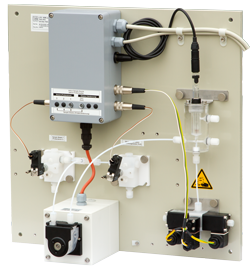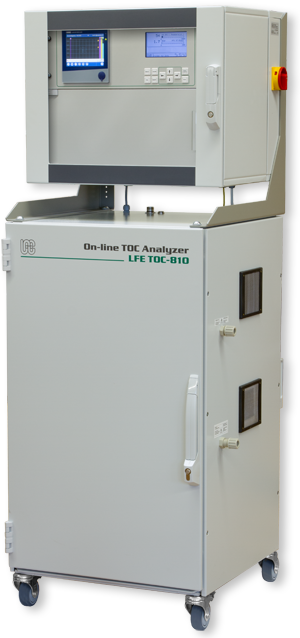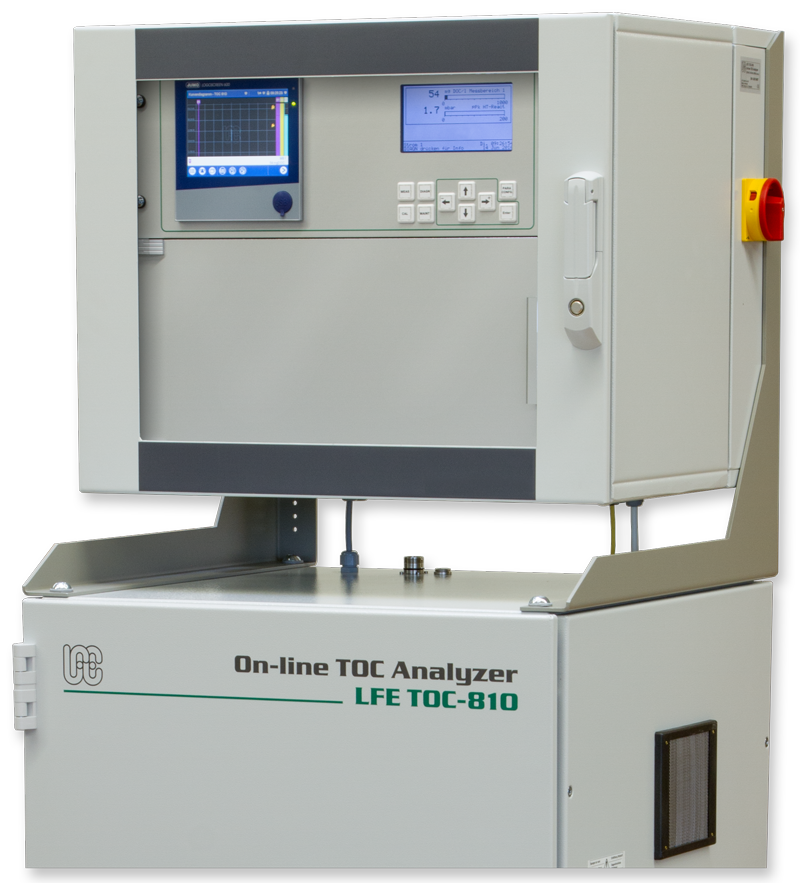Features and typical applications
Features and typical applications
Key Features
- Continuous real time analysis
- Continuous fast sample conditioning
- Quick response to changes in TOC level
- High temperature oxidation
- Extraordinarily stable measuring characteristics
- Reliable system calibration
- Highest operational reliability
- Intelligent self-monitoring
- Designed from the ground up for process analysis
Typical Applications
- Pure water monitoring (e.g. boiler feed water, condensate)
- Production facility monitoring
- Drinking water monitoring
- Mixed drainage water monitoring
- Influent and effluent wastewater treatment monitoring
- Airport de-icing water treatment monitoring
Description
Description
The TOC-810 represents the newest generation of LFE's on-line TOC-analyzers. These have proven themselves with considerable success in use at many chemical plants as well as other important industrial companies since the beginning of the '80s.
The LFE TOC-810 has evolved out of real-world applications as an on-line analyzer for the continuous TOC registration of highly- as well as low contaminated water. The demands placed on every component of such an on-line TOC-analyzer require special design solutions.
Continuous analysis with nearly 100% carbon conversion
- High temperature oxidation for the complete conversion of all organic carbon compounds
- Continuous analysis with short sample injection cycles (typ. < 10 sec)
- Continuous sample conditioning for improved real time analysis
Analytical precision
- Highly selective CO2 analysis without water vapor interference
- Instrument specific linearization
- Reliable full system calibration with calibration solutions
Special detail solutions for highest operational reliability
- All components meet the highest requirements for long term operational reliability.
- 100% process design - NOT a modified laboratory instrument
- Purgable cabinet section for NDIR photometer and main electronics as well as encapsulation of peripheral electronics
- Spatial separation of water bearing components
- Consistent use corrosion resistant materials
Comprehensive intelligent self-monitoring
- Distinction between operational and maintenance-related impairments
- Output of alarm conditions via analog and digital outputs as well as a plain text description on the LC display
Outstanding reactor service-life
- The dimensioning of the analytical parameters allows maximum possible reactor service life in combination with the fastest possible response time.
- "Quick reactor change" design for high operational availability
Simple operation
- All relevant instrument functions shown in plain text on the LC display
- Intuitive user interface
- Optimized instrument design for ease of maintenance
Extraordinarily stable measuring characteristics
LFE develops and manufactures key components in order to attain exceptionally stable measuring characteristics.
- Low maintenance, high precision metering pump
- Especially high quality NDIR photometer system with a corrosion resistant analysis cell specially developed by LFE
- Self-adapting gain control for long term span stability
Signal & status outputs
- Optional digital chart recorder with data storage function
- Up to 6 analog outputs (0(4)-20 mA) for measured values as well as peripheral system values
- Up to 8 digital inputs and 10 digital outputs
- RS-232 interface
- Modbus TCP interface
- All inputs and outputs are individually configurable.
Options
Options
- Acidifier/ Sparger/ Multiplexer-unit
(ASM-unit; wall mounted)
The basic TOC-810 instrument functions as a TC-analyzer. The ASM-unit facilitates the removal of inorganically bound carbon (TIC).
This unit can be equipped with further options:
- automatic calibration for 3 test solutions
- Multiplex capability (3 sample streams)
- Sample dilution stage
- Simultaneous, selective VOC- or TIC- analysis
in conjunction with 2nd NDIR measuring channel and the Acidifier/ Sparger/ Multiplexer-unit - Analog expansion module
expands the system from 2 up to 6 configurable 0(4)-20 mA analog outputs - Digital expansion module
8 digital inputs plus expansion of system from 3 up to 10 digital outputs - RS-232 serial interface
- Modbus TCP interface
- Built-in paperless recorder
VOC-analysis package
Unique VOC Analysis Package (optional)
Background
Aside from the intentional removal of inorganically bound carbon (TIC) the sparger air can also inadvertently expel volatile organic carbon (VOC) compounds which escape detection.
The TOC-810 can be fitted with an optional package in conjunction with a 2nd photometer channel which simultaneously and continuously measures the VOC-level independent of the TOC- (or DOC-) analysis.
Functional Principle
The potentially VOC-enriched sparger air is split into two parallel gas streams each containing the CO2 background level representative of the TIC level of the water sample as well as possible VOC.
- The 1st gas stream is passed unaltered through the reference cell of the differential CO2 photometer channel.
- The 2nd gas stream is passed through a catalytic converter stage in which any VOC is oxidized to CO2 and added to the background CO2 level. This stream is sent to the sample side of the differential CO2 photometer.
The difference in IR radiation absorption in the photometer channel corresponds to the VOC concentration of the water sample.
The inherent response of a differential NDIR photometer to varying background levels is dynamically corrected for by the implementation of LFE's patented gain stabilization / common mode rejection algorithm.
First introduced by LFE in 1989, this unique method totally eliminates the need for a CO2 scrubber. The resultant maintenance requirements for the VOC analysis are minimal.
Technical data
Technical Data
Enclosure and Electrical Data
| Property | Specifications | |
|---|---|---|
|
Technical specifications subject to change without notice |
||
| TOC-Analyzer (main instrument cabinet) | ||
| Cabinet | 2-section 19" cabinet on lockable rollers; active ventilation via filtered fans; electronics section purgeable |
|
| Dimensions (h x w x d) |
1690 mm x 650 mm x 650 mm | |
| Power | 220/230 VAC - 50/60 Hz (other line voltages on request) continuous operation: 550 VA (Warm-up phase: 800 VA) |
|
| Acidifier / Sparger / Multiplexer unit (option) | ||
| Construction | Components on polypropylene panel for wall mounting | |
| available options | acidifier-/sparger stage, automatic calibration, stream multiplex, supplemental peristaltic bypass feed pumps | |
| Dimensions (h x w) |
Basic unit: 500 x 500 mm Extended unit: 500 x 665mm (provides room for additional optional peristaltic pumps) |
|
Analytical-Operational Data
| Property | Specifications | |
|---|---|---|
|
Technical specifications subject to change without notice |
||
| Analytical-/Operational data | ||
| Measured quantity |
Basic instrument: TC
With optional sparger-unit: TOC/DOC as well as optional simultaneous VOC analysis |
|
|
TC/TOC/DOC
|
VOC- measurement principle (optional)
|
|
| Principle[2][3] | High temperature combustion (typically 950°C) of water sample with subsequent photometric CO2 analysis in the dried reactor exhaust (Peltier sample gas cooler). • lowest range : 0 - 5 mg C/l (lower ranges on request) • highest range : 0 - 5000 mg C/l |
Sparger air analyzed for volatile organic carbon components utilizing catalytic conversion with subsequent photometric CO2 analysis in a dedicated channel. The differential operation of this channel alleviates the need for a CO2-scrubber. • lowest range : 0 - 10 mg VOC/l • highest range : 0 - 300 mg VOC/l |
| Response Time[2] | t90: typically 5 min. (continuous analysis) |
t90: typically 2 min. (continuous analysis) |
| Precision[2] | better than ±1% of FSO | better than ±1% of FSO |
| Accuracy[2] | better than ±1% of FSO | better than ±2.5% of FSO |
Instrument Interface
| Property | Specifications | |
|---|---|---|
|
Technical specifications subject to change without notice |
||
| Inputs and outputs | ||
| Read-out | LC-display (40 characters x 16 lines) and user interface based on NAMUR recommendation Language switchable between English and German |
|
| Instrument Status | Plain text description on the LC-display as well as categorization into one of the following states (NAMUR NE 107 compliant[1]): FAILURE | FUNCTION CHECK | MAINTENANCE REQUIRED |
|
| Analog signal output | 2 current outputs (standard; optionally expandable to a total of analog 6 outputs) 0(4)-20 mA (RLoad = 600 Ohm max.; all outputs isolated and individually configurable) • 0-20 mA or 4-20 mA • 4-20 mA with superimposed instrument status (NAMUR NE 43 compliant[1]) • Test signal levels |
|
| Digital outputs (standard) |
3 digital outputs for instrument status (NAMUR NE 107 compliant[1]) FAILURE | FUNCTION CHECK | MAINTENANCE REQUIRED (relay contacts 28 V max.; 350 mA max.) |
|
| Digital I/O expansion module (optional) |
Digital inputs • 8 configurable inputs (6 – 24 VDC; 10 mA max.) • Sample stream selection, calibration solution selection, initiation and cancellation of AutoCal Digital outputs • 7 configurable outputs (relay contacts 28 V max.; 350 mA max.) • thresholds, feedback as to sample stream, calibration solution and AutoCal etc. |
|
| Modbus interface (optional) |
• Modbus TCP | |
[1] NAMUR: Standardization commission for measuring and control technology in the chemical industry (sub-committee for operability of microprocessor-controlled process analytical- instrumentation)
[2] Data dependent on instrument configuration
[3] Range specifications using standard instrument parameters, without optional sample dilution.
Lower and higher ranges on request
Downloads
Downloads 
TOC-810 On-line TOC Analyzer
Technical specifications subject to change without notice



